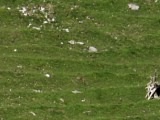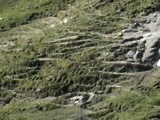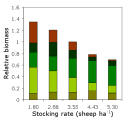|
Mechanical impact
Besides the direct effects of defoliation, there is a large mechanical impact of
livestock animals on pastures. Individual hoof-marks of cattle create a small-scale
heterogeneity on the soil surface, and at a larger scale can cause soil
compaction because of the heavy weight of the animals. The traditional alpine cattle were considerably
lighter than modern breeds and caused less damage to the soil.
Wet, peaty soils are especially vulnerable to trampling, which can lead to a serious destruction
of the turf. Also, in areas of extreme use such as the surroundings of gateways and water troughs,
repeated treading may lead to an open or non-existent vegetation cover and consequent loss of soil.
Cattle may promote tussock grasses through their tendency to avoid treading on tussocks.
In one study it was shown that only 5% of footsteps by cattle in a Nardus pasture were directly onto a
tussock, while 90% avoided tussocks altogether. Regular trampling on the spaces between tussocks leads
to soil compression, impedes water infiltration and makes the spaces poor microsites for colonization;
meanwhile, the tussocks may benefit from reduced competition.
On relatively steep slopes, almost all livestock species tend to walk in rows parallel
to the slope while moving and grazing. Due to this peculiarity, small terraces
parallel to the slope, so called "Viehgangeln" are formed.
Below, you see some examples. What do you think are the consequences for the natural
environment?
|

 3
3
 4
4
 5
5
 6
6
 7
7
 8
8
 9
9

